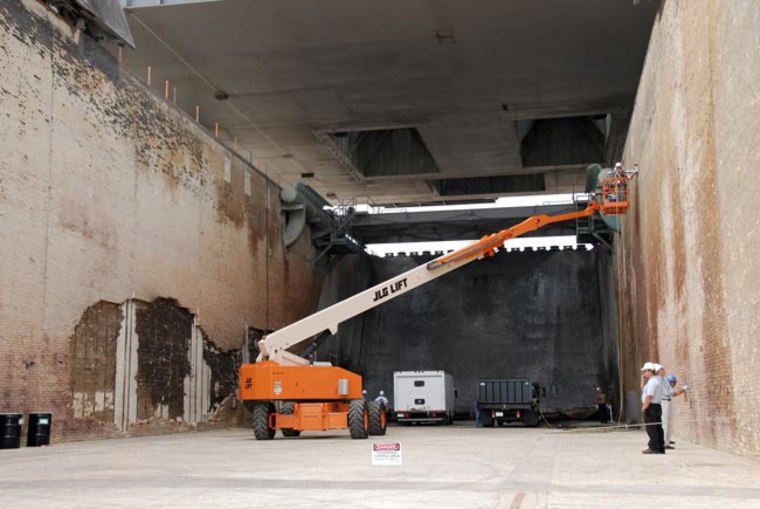NASA will start fixing a damaged Florida launch pad Friday in preparation for the October launch of space shuttle Atlantis in a mission to repair the Hubble Space Telescope.
The intense pressure from space shuttle Discovery's May 31 launch tore bricks from the wall of Launch Pad 39A's flame trench and sent some pieces flying at supersonic speeds, but NASA officials said that the incident did not pose a threat to the space shuttle or its launch schedule.
"It's not a flight [safety] issue at all," said Rita Willcoxon, space shuttle processing manager, during a Thursday teleconference where she and other officials laid out the results of NASA's investigation and repair plans.
NASA engineers found that time and environmental effects had eroded the adhesive materials holding a layer of heat-resistant bricks against the east wall of the flame trench. Vibrations during Discovery's launch caused that layer to bend outwards slightly, and allowed a hot gas plume to enter behind the bricks.
"Due to interlocking nature of the bricks, that led to cascading failure," said Perry Becker, head of the Engineering Investigation Team.
The thrust from Discovery's engines blasted 3,500 bricks (newly revised estimate) from the wall and left them strewn across 1,500 feet (457 meters) between the flame trench and the pad's perimeter fence. However, simulations run by the engineers showed that none of the bricks flew up near the pad surface, and therefore posed no possible risk to the space shuttle.
Slideshow 12 photos
Month in Space: January 2014
Erosion has similarly taken its toll on the intact west wall of the flame trench. NASA crews plans to work with an outside contractor to repair the damaged east wall, but will also replace a 25-foot high by 80-foot wide section of the west wall's bricks using a spray-on, heat resistant material.
NASA has two launch pads for Atlantis and the remaining shuttle missions, but will need both ready for the Hubble repair mission in case a second shuttle must fly on a rescue mission. That's because Atlantis will have to fly to a higher orbit than normal to reach the Hubble Space Telescope, and would not have fuel to reach the safe haven of the International Space Station during an emergency.
The repair effort would allow plenty of time for the Atlantis launch to proceed as planned, NASA officials confirmed. Brick removal starts Friday and ends on July 19, and the wall repair is slated to go from the third week of July until the third week of August.
"That repair will remain intact until the end of the shuttle program," Willcoxon said. She added that the total cost for the flame trench facelift was expected to fall under $2.7 million.
NASA already has plans to redo the launch pads after the shuttle's retirement, and prepare them for the Ares I rockets that will carry the Orion capsule replacing the shuttle.

